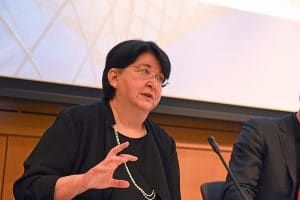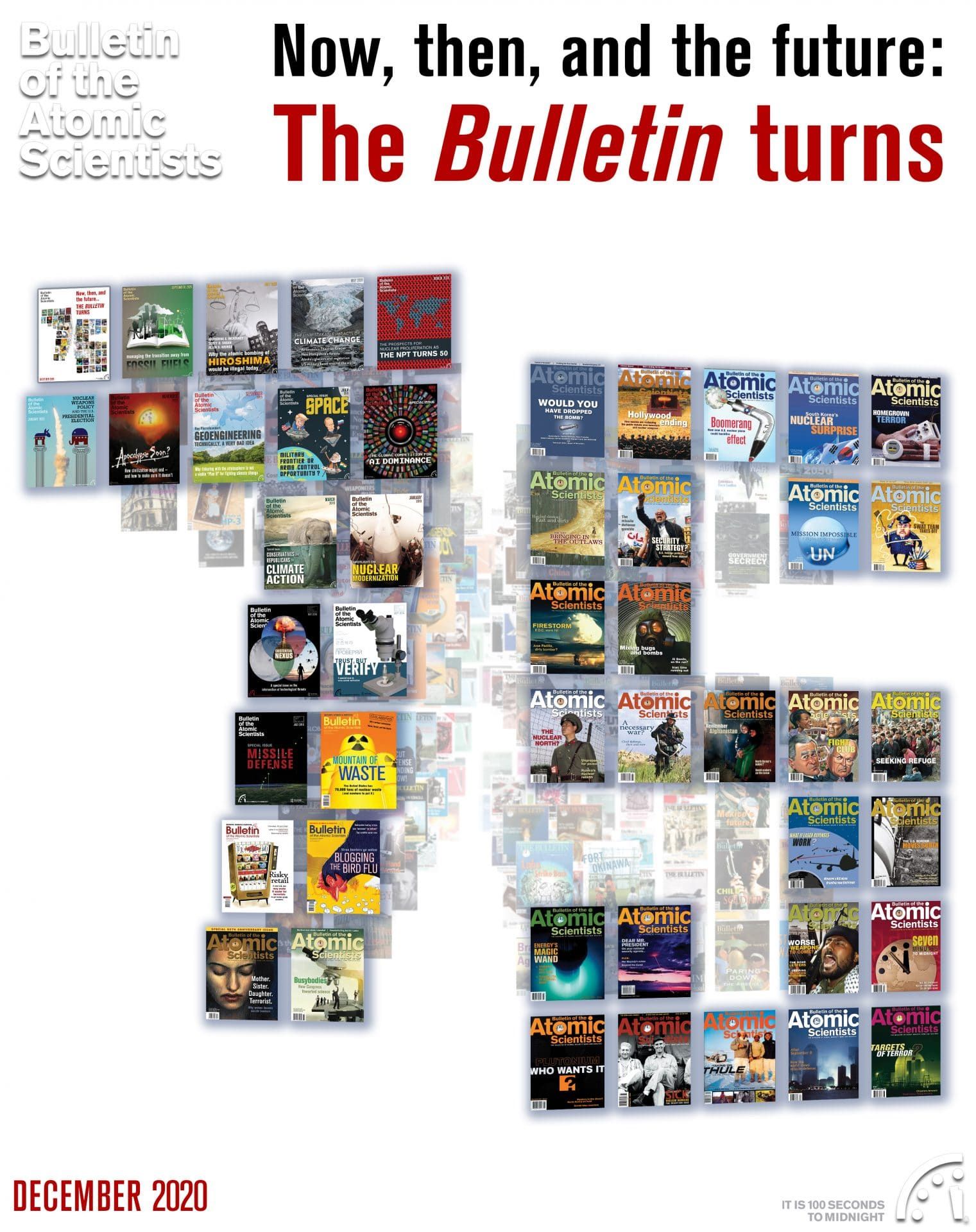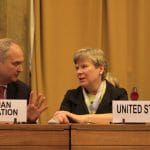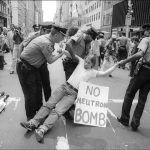Transforming our nuclear future with ridiculous ideas
By Emma Belcher | December 7, 2020
Transforming our nuclear future with ridiculous ideas
By Emma Belcher | December 7, 2020
Seventy-five years after the only use of nuclear weapons in war, the United States finds itself in a national security crisis that has little to do with missiles and everything to do with a failure to prioritize what truly keeps us safe. After warnings about possible pandemics went unheeded, we were caught flatfooted and the abstract quickly became real. Globally, we’ve endured disruption to our way of life, and the physical, mental, and economic impacts that have resulted from isolation. This should serve as a wake-up call: As awful as the pandemic has been in terms of death and economic disruption, its effects are minuscule in comparison to the global catastrophe that nuclear war would create.
The shock of COVID-19 has prompted a reckoning about a situation that has been there all along—the unacceptable risk to our future that we tolerate, when we tolerate nuclear weapons. We place our faith in a deterrence theory—a theory that is vulnerable to accident, mistake, and miscalculation—to protect us against the use of even a small number of the thousands of nuclear weapons still in existence. Combined with a historically insular and siloed nuclear policy field and a tendency to favor immediate results over long-term thinking, we have precluded our ability to transform the future.
Just as the end of World War II prompted an organizing structure embodied in the United Nations system, we must emerge from COVID-19 with a vision of the type of future we want and the kindling for a plan of how to get there. When it comes to nuclear weapons policy, our vision has to be pragmatic, but it also has to be audacious. To achieve this balance will require that we explore multiple scenarios, recognizing that we can’t predict the future. But we can—and we must—be prepared for a range of plausible outcomes so we know how to ensure global security without relying on a demonstrably problematic theory about nuclear weapons as deterrents. In other words: We are bound to live through significant uncertainty and unexpected shocks (just as we are doing today), but we won’t allow them to render us incapable of achieving goals of reducing and eventually eliminating nuclear weapons.
Our success will rely on several interrelated factors: A revitalized nuclear policy field that recognizes the power that comes from greater diversity in all its forms, new partners willing to share their knowledge and expertise, and bold new ideas—some of which, by design, will appear ridiculous at first.
The case for ridiculous ideas: seeking transformative change
In this moment of reflection about how we conduct business, how we interact as humans, and what “COVID-normal” will look like, there is ironically an opportunity to transform the dangerous nuclear situation. It’s an opportunity to ask: What kind of world do we want to live in, anyway? How will we define “safety” or “security” or “stability” in a post-COVID world? And what role—if any—should nuclear weapons play in that future?
Asking and answering these questions will empower us to change the game and advocate for the kind of future we want for ourselves, our communities, and future generations.
To ask and answer these questions properly, we need to change our approach with respect to people and methods. Smart people have been working on this problem for decades—seven-and-a-half, to be precise—and we, as a global society, still haven’t cracked it. And there’s danger in using yesterday’s logic to approach today’s problems.[i] So, we need to challenge long-held assumptions in a new way. We can look at other issue areas for clues, and at case studies of other seemingly intractable problems, such as Apartheid, marriage equality, and racial justice.
Trusting the process
There are processes for approaching apparently intractable problems that have worked in the past. We know that a more diverse group of people has a greater chance of diagnosing problems and developing solutions that truly keep all of us safe. In the nuclear field, achieving this diversity will require a concerted effort to welcome new players, to be willing to challenge assumptions and have our assumptions challenged, and to be open to new techniques.
The good news: An effort that includes diverse voices and methods to think big about where we’re going already exists. Emerging and established professionals are increasingly collaborating on how to improve the nuclear policy field, engaging in difficult but necessary conversations, and the field is becoming more diverse. Over the last five years, marketing and branding experts, designers, gamers, lawyers, political commentators, and influencers with connections to leaders in other fields have been drawn into nuclear policy discussion. This has resulted in new partnerships, collaborations, and projects, and even new organizations dedicated to combating nuclear threat. As a result, the field is experiencing a kind of reinvigoration.
One recent project applied virtual reality to facility inspections through a collaboration between nuclear scientists and game designers. In an upcoming project, experts in the fields of neuroscience, behavioral psychology, disruptive technology, and nuclear threats will seek a deeper understanding of how risk and decision-making impact the safety and integrity of the global nuclear weapons infrastructure. This work is motivated by the fact that over the last half-century there have been significant scientific advances in the understanding of risk and decision-making, particularly in the fields of psychology and behavioral economics, yet the theory and practice of nuclear deterrence has remained static. The project will seek to more accurately understand the risks associated with individual decision-making around nuclear weapons use, including human assessment and assignment of risk, the ability to make decisions under pressure, and the cognitive skill sets of individual “deciders” and the chain of command. Among other things, the experts plan to examine the potentially dire consequences of outsourcing some components of the nuclear launch decision to machines instead of the typical human deciders.
There are also collaborative efforts to “think big” about the nuclear problem.
A consortium of nuclear experts, systems experts, and designers are using a “three horizons” planning framework.[ii] The first “horizon” is the present: The team is developing a map of the current global security architecture, looking for novel ways to advance policy change. The third horizon is the future: The team is exploring multiple data-driven scenarios for managing global security in the year 2045. Based on analysis of both present and future, the team will flesh out the second horizon: A “whole of society” period of transition and innovation involving partners with varying worldviews, experiences, and professional expertise.
While devising a process for a phased nuclear disarmament has certainly been tried before, these exercises have largely failed to yield fruit—perhaps because the work has taken place in a bubble. This new effort might break through the impasse and intentionally open up the game to other players for the contributions and insights that might help us get unstuck.
The discipline of strategic foresight has recently captured the attention of an interesting cross-section of nuclear professionals. Foresight—perhaps the most familiar, but by no means only, method being scenario planning—is a disciplined process of analysis that begins with observing signs of change and exploring critical uncertainties that will impact how the future unfolds. Strategic foresight is both a way of generating bold new ideas and testing them. Futures work engages both imagination and intellect and provides the framework in which people can think both strategically and provocatively.
One concept from the foresight discipline seems particularly insightful: “Any useful statement about the future should at first appear to be ridiculous” (Dator 1995). In a thought-provoking article, Peter Waring draws the inextricable link between nuclear weapons and states (2020)—“[n]uclear arsenals are not innocent artifacts but are instead complicit in defining the structure of the international system.” Therefore, “[s]olving for nuclear weapons is thus largely reliant on solving for the nation-state.” Waring challenges us to question our assumptions about the inviolability of the state-based system and to be open to the possibility that states might disappear and along with them nuclear weapons.
At the very least, if the future is one in which states share the playing field with novel forms of international organizations and sub-entities of megacities and regions, Waring posits, there might be new points of leverage to solve the nuclear problem. Waring’s idea, which could be dismissed as “ridiculous” by some, just might be the useful one in hindsight.
The stumbling blocks
Any effort to realize transformational change will encounter resistance. Stubborn factors perpetuate the status quo: They are why we’re stuck in the first place. In the nuclear field, there are several interrelated reasons for our stasis:
Dominant framework. A significant aspect of the problem is the stranglehold that game theoretic approaches maintain over the nuclear policy field, and their stubborn predominance, despite their at times contradictory logics and vulnerability of nuclear deterrence to mistake and miscalculation. While many assert that the absence of any nuclear detonation in war since 1945 proves that nuclear deterrence works, others question whether this has been luck (Pelopidas and Wellerstein 2020). Certainly, many instances of near misses have been recorded.
Since its heyday in the 1950s, game theory has fallen out of vogue in other areas (Waring 2020), as fields like behavioral economics have come to the fore (Ariely 2009). Why game theory has survived so strongly as the predominant framework in the nuclear field is an interesting question. The continued reliance on arguments based on rational-actor models—models that exclude real world stresses, time pressures, lack of information, doubted information, and understanding of human behavior—is not only difficult to comprehend but disconcerting. In many other fields of human behavior, research has shown that human beings are often—perhaps even usually—not rational actors. Why the continued assertion that the human beings with their fingers on nuclear buttons will always act rationally?
The persistent dominance of this theory in the face of these challenges is indeed puzzling—until one considers who stands to benefit from the status quo. The planned replacement of US intercontinental ballistic missiles (ICBMs) for a cost of at least $260 billion illustrates important factors at play (Capaccio 2020). Despite many defense analysts recognizing that ICBMs are not needed for nuclear deterrence—it’s much more likely that the military would turn to nuclear bombers or submarines in a crisis—and despite a usually divided public favoring their phaseout (University of Maryland 2020), Northrop Grumman has just been awarded a $13.3 billion contract for the engineering and manufacturing development phase (Northrop Grumman 2020). As William Hartung suggests (2020), non-strategic factors nourish the ICBM force. Hartung shines a light on Northrop Grumman and “the intense lobbying activities of the Senate ICBM Coalition—composed of senators from states that host ICBM bases or maintenance activities.” The military-industrial complex stands to benefit from the dominance of nuclear deterrence theory, which is used to justify these weapons’ existence.
Attempts to bring in other perspectives that might challenge the theology of nuclear deterrence are often derided. Proponents of disarmament, let alone abolition, are roundly dismissed as naïve. Practitioners who ascribe to either nuclear deterrence or disarmament frameworks are often pitted against each other in a black and white manner that can stifle curiosity and problem solving.[iii] Once assigned to a side, through self-selection or in some other way, those involved in nuclear policy discussions can find it difficult to attempt to understand others’ positions or engage with them without being accused of betraying their team. The field also suffers from a tension between dominant American scholars and scholars from other parts of the world. Clearly, with over 90 percent of the world’s nuclear arsenals between it and Russia, the United States has a particular voice on this topic. But US actions have global consequences, and often outsiders can see things that those embedded in the system cannot.
Sadly, these divisions are a reflection of the polarization within societies more broadly. We’re now at a point where the two “sides”—non-weapons possessors versus possessors and their allies—are at loggerheads, epitomized in the bitter discourse surrounding the nuclear weapons ban treaty. The tension is significant, and it’s dangerous.
Lack of diversity. While certainly a buzzword that doesn’t always lead to practical action, diversity (or, rather, the lack of it) is clearly part of the reason that military budgets stay large in a world where many of the most serious challenges cannot be solved by military action. In addition to being in line with a values-based approach, the benefit of diversity in solving problems and increasing productivity is well documented. Not only is this the case in the business world (Dixon-Flye, Dolan, Hunt, and Prince 2020; Turban, Wu, and Zhang 2019), but it also translates to foreign policy (Bigio and Vogelstein 2020; Wertz 2006).
Yet the nuclear policy world is infamous for its insular nature, with its club-like status and inside-speak. Little has changed on this front since Carol Cohn’s famous expose, “Sex and Death in the Rational World of Defense Intellectuals” (Cohn 1987), on the “technostrategic” language of defense intellectuals, one that jumps between the abstract and the erotic in its focus on “countervalue attacks,” “collateral damage,” “vertical erector launchers,” and “deep penetration” to describe the very real process of incinerating human cities. The theoretic beginnings that so stubbornly persist today were developed by male academics at elite universities and the RAND Corporation. While women of all backgrounds have been present since the early days of the nuclear field and a number have held leadership positions, many report experiencing hostility and pressure to “master the orthodoxy” to be taken seriously, as articulated by former Under Secretary of Defense Michèle Flournoy (Hurlburt, Souris, Stark, and Weingarten 2019).

Challenges in the field apply particularly to women of color. Nuclear policy does not escape the systemic racism that is prevalent in American society. In the Bulletin’s own pages, Katlyn Turner, Lauren Borja, Denia Djokić, Madicken Munk, and Aditi Verma have well articulated the significant barriers to entry for Black women, Indigenous women, and women of color and the challenges for those who do find work in the field (Borja, Djokić, Munk, Turner, and Verma 2020). In addition to depriving the field of the diversity that would be so beneficial, these barriers mean that those who are particularly affected by the nuclear weapons complex (because of materials extraction and testing near historically impoverished and marginalized communities, among other things) are absent from input into solutions.
New America’s groundbreaking Consensual Straightjacket report outlined the experiences of 23 women who’ve worked for several decades in the nuclear policy field (Hurlburt, Souris, Stark, and Weingarten 2019). It sums up the problems of dominant frameworks and the lack of diversity aptly:
The sub-field of nuclear posture and deterrence policy, and, on the military side, the people who actually handle the weapons, was described by respondents as closed-off and highly hierarchical, tending to value long experience and insider knowledge above innovation. Respondents described this field as insulated, male-dominated, and unwelcoming, with a small group of long-time insiders controlling what new ideas and individuals would be considered. Its discourse, they said, is characterized by highly abstract logic.
Diverted attention. During the Trump era, nuclear experts have been responding to nuclear crises as they occurred, trying to prevent further deterioration, hold onto gains, and promote better policies wherever possible. It’s been hard to deal with all of the crises, many of them manufactured by an administration that conducts foreign policy by tweet. It’s also been hard to find the time, energy, and mental clarity to think about where America and the rest of the world are going.
Early indications are that Biden will return nuclear policy to a saner one and reestablish US leadership on nuclear issues (Glasser 2020). But will it be “enlightened” enough? Will he and his team have the vision for what’s to come, and how to capitalize on this moment to bring about transformative change that we and this world most desperately need?
Finding the ridiculous idea
In a resource-squeezed world in which there is a premium on results, committing to a bold new approach will be difficult. But the times we live in call for a big rethink.
It is unlikely that new thinking resulting from new techniques will permeate the inner circle of the so-called nuclear priesthood, at least not for a while. Certainly, the resistance against it will be strong, in no small part because of the significant money and jobs involved, territorial sensibilities, and special interests (private and public). But any conscious effort to break through previous failures to chart a path toward nuclear disarmament will be more likely to succeed if it draws on knowledge from the past. What might require a “hack” from a new direction at the moment will ultimately stand a greater chance of success if it includes the points of view of the “old guard,” and if the old guard’s members are seen as knowledgeable rather than obstacles. But that old guard needs to respect the aspirations and ideas of the newcomers.[iv] After all, the one thing that binds all sides together is a desire to avoid nuclear war. The sooner we can create space for civil discourse that eschews polarization, the better.
There is an idea out there that could solve the nuclear problem, but we won’t find it by adhering to the status quo. By attracting additional people from diverse backgrounds to the field and investing in new ideas, we can catalyze the idea that revolutionizes the nuclear future – the idea that might appear ridiculous at first.
Together, we make the world safer.
The Bulletin elevates expert voices above the noise. But as an independent nonprofit organization, our operations depend on the support of readers like you. Help us continue to deliver quality journalism that holds leaders accountable. Your support of our work at any level is important. In return, we promise our coverage will be understandable, influential, vigilant, solution-oriented, and fair-minded. Together we can make a difference.
Keywords: deterrence theory, diversity, game theory, nuclear policy
Topics: Nuclear Risk, Nuclear Weapons





















